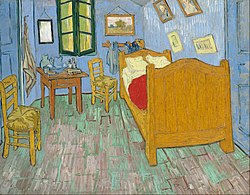Picture Prompts and the Magic of Masterpieces: How Visual Art Can Be a Superfood for Developing Writers
- Susan Koehler
- Jul 29, 2025
- 5 min read
Ask anyone for a writing prompt, and they’ll probably give you some words. However, it’s important to remember that writing prompts do not always have to be verbal. Images, generally referred to as picture prompts, are often more effective.
Images are a natural catalyst for descriptive writing. You can clip them from magazines, download them from public domain sources, and create your own meaningful picture prompts.
But consider this: while simple pictures are powerful, artistic masterpieces are magical. Art can foster innovation, promote critical thinking, and reach students on an emotional level. Art is like a superfood for developing writers. Let’s take a look at four masterpieces and explore their potential as catalysts for writing.

Vincent van Gogh, The Bedroom, 1889 (second version)
Also known as Bedroom in Arles, Van Gogh created three versions of this painting over the course of a year. My eldest daughter, while attending a wonderful preschool, was introduced to this painting as part of an art project in her Pre-K 4 class. I soon discovered that many teachers had used this painting as a prompt for both visual art and writing.
Ideas for using The Bedroom as a writing prompt:
Identify colors and use specificity to name them (e.g., crimson, honey-colored, lilac). Then, write a description of the painting using these specific color names.
Create a character who lives in this room. Write a character description that identifies the character's attachment to some of the articles found in this room.
Work collectively to write a description of this bedroom. Then, have students sketch images of their own rooms – either real or imagined – and write individual descriptions of these rooms.
Resources to Explore
Check out The Art Institute of Chicago for more information about the artist and more exposure to his works.
The Van Gogh Museum offers specific lessons for primary students and for secondary students.
The Institute for Arts Integration and Steam even offers plans for using this series of paintings to develop expository writing.

Pierre-Auguste Renoir, Two Sisters on the Terrace, 1881
When I was a kid, I loved playing board games. One of my favorites was a game called Masterpiece, in which players buy and sell art. I don’t remember the actual game itself as well as I remember the paintings it included, each on its own shiny card with details about the painting on the back. This game was probably my first exposure to these masterpieces, and one that I particularly loved was Renoir’s Two Sisters on the Terrace.
Ideas for using Two Sisters on the Terrace as a writing prompt:
Create a list of verbs that tells what’s happening in this still-life image. While verbs ascribed to the sisters might be more direct (e.g., sit, stand, gaze), students will need to develop personification to assign action words to the objects and background (e.g., listens, waits, meanders). After developing a list, students can use these verbs to write a descriptive piece about the painting.
Develop the scene by exploring the setting, the circumstances that may have led the sisters to this place, and the emotions displayed in their facial expressions and body language.
Work collectively to write a description of these characters. Then, have students sketch images of two other characters – either real or imagined – who are similarly placed in a setting.
Resources to Explore
Check out The Art Institute of Chicago for more information about the artist and more exposure to his works.
Seek inspiration from the stories and poems about Renoir that were written by readers of Stone Soup Magazine.
Help students understand the processes used by Renoir with this Meet the Masters art lesson and use their understanding to prompt procedural writing.

Walter Ellison, Train Station, 1935
Trains are fascinating, and this Walter Ellison painting of a busy train station is alive with activity. Ellison’s style brings the figures to the forefront in a way that is reminiscent of an old-fashioned felt board or a modern collage. The vibrance, motion, and momentum of this artwork give it great potential for inspiring creative ideas. For students ready to explore the context of the time period, it can also bring history to life.
Ideas for using Train Station as a writing prompt:
Work with students to list as many singular nouns as they can find in the picture (e.g., hat, sign, shoe, archway, light, suitcase dog). Each student should select at least three of these nouns, generate adjectives to describe the nouns, generate verbs to tell what those nouns are doing (even if that means using personification), and build a descriptive piece from their word bank.
Introduce students to the Great Migration of the 1920s. Have them select a character within the painting and write a journal entry to tell about this character’s hopes, dreams, and travel itinerary.
Work collectively to write a free verse poem to tell about what’s happening in this photo. Have students create collages of busy places familiar to them – a classroom, the school cafeteria, a playground – and write their own free verse poems.

Dorothea Lange, Migrant Mother, 1936
This photograph has become an iconic image of The Great Depression. Photographer Dorothea Lange was employed by the federal government to document the lives of ordinary people during an extraordinary period of American history. This photo was taken in California while Lange was on assignment with the Farm Security Administration (previously known as the Resettlement Agency).
Resources to Explore
Check out the Library of Congress Research Guides to learn more about this series of photographs.
Learn the story behind the photo from the Museum of Modern Art and have students write free-verse poems to express the emotion context of the situation.
Explore more of Lange’s works at the National Gallery of Art. Allow students to each self-select one of Lange's work and write a story about the people shown.
The ideas for using visual art to prompt writing are endless. You’re probably generating ideas of your own as you read. But there is something else important to know about art: it’s also good for the brain. In fact, studies have shown that art can have positive effects on both our mental and physical health.
In their book Your Brain on Art, Susan Magsamen and Ivy Ross explain the science of “neuroaesthetics” and make the case that we should incorporate art into our lives because of its positive effects on both our physical and mental health. You can read more about this book in Greater Good Magazine.
If you’d like to delve more into how and why art can enhance cognition, emotional well-being, mental health, and child development, check out the East End Arts and Humanities Council.
If you want to learn more about how art can reduce stress and improve memory, read Your Brain on Art: Enhancing Neuropsychological Capabilities in Psychology Today.
Research and experience both support the idea of using visual art in the classroom. Not only does it have to potential to inspire great writing, but visual art can also have a positive impact on emotional well-being, mental health, cognitive development, memory, and critical thinking. Visual art truly is a superfood for developing writers!















Comments